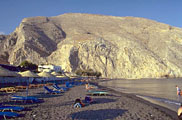

This was our last day on Santorini, which was sad. We liked the island very much, though we probably would like it less later in the season when it is said to be very crowded. It's crowded enough even when we were there, when the cruise ships are in. But those crowds do not go much outside Fira, whereas the summer crowds are said to fill the beaches on the flat outer shores (thinking of the caldera cliff as the inner coast) as well as the outlying towns such as Akrotiri and Oia. Nor do most go where we went this day--Ancient Thera.
 |
 |
| Mesa Vouno from Perissa beach. Ancient Thera covers much of the top of it. The previous day we had tried to walk up to the saddle at the far left of the picture, along the side of the gully. Photo by Tom Pfeiffer (used with permission) | The road up to the saddle between Mesa Vouno and Profiti Ilias, from Kamari (the opposite side of the saddle from that seen in the picture at left). This top part of the road was swept away by a landslide a few years ago, and is now in much better shape than the bottom part. |
We read the Lonely Planet guide a bit more, and discovered that there was another way to get to Ancient Thera, besides the path we failed on from Perissa. Ancient Thera is on a1200ft high rocky peak that juts into the sea, called Mesa Vouno. On the other side of Mesa Vouno is another beach resort town called Kamari, and from there a road up to Ancient Thera. So we thought we would try again to see Ancient Thera.
We started up the steep hairpins on a narrow road with very rough cobblestones. Before the first turn I decided discretion was the better part of valour, and backed down again. Luckily, at the bottom there was a shop offering a ride up in a minibus every hour on the hour . Nobody was home, as it was just after 10:00, and the owner/driver was up on the road somewhere. So we wandered down to the black sand beach and enjoyed a leisurely coffee before going back.
The owner/driver of the minibus was very pleasant, and suggested we park the car in his private place that was plastered with strong prohibitions against doing just that. The drive up was a bit scary, but he said that there had never been a car accident on that road. Motorbikes, yes, going too fast to take the corners, but not cars. I didn't see how he could tell that his downslope front wheel would not go over the edge at many of the hairpins, but I figured he had been going up and down this road for years, so it was probably going to be OK--and it was. We mentioned the wind of yesterday, and he said he had had customers who came up to the saddle with him and had gone right back down with him for fear of being blown off!
Once up at the saddle, there is still some climbing to do. The top of the hill is at 369m, or a bit over 1200 ft, and the saddle is about 100m lower. Here is a map of the site, with contour lines.
 |
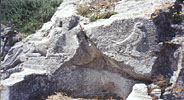 |
| A street in Ancient Thera. (The towers on the top of the hill are the military radio towers on Profiti Ilias). | Carving of lion and a Horus falcon in Ancient Thera. I have forgotten who the shrine honours. |
Ancient Thera is a Dorian fortress, though it was occupied well into the Roman era, and has much Egyptian about it as well. It was occupied over a span of some thousand years. After seeing this site and the Lato site in Crete, I decided I did not like the Dorians very much. They seemed crude, unartistic, and warlike. Fortresses in high, inaccessible kinds of places seemed to be their way of life, in contrast to the totally unfortified Minoan palaces. Maybe I should not judge on so little evidence, but "grey lumpy" seems to describe their architecture, such of it as we saw.
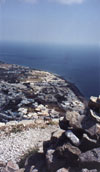 |
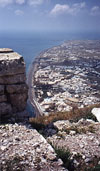 |
| Kamari (left) and Perissa (right) seen from Ancient Thera | |
From the seaward tip of Ancient Thera, one can look down on Perissa to the south and Kamari to the north, a thousand feet below. In the same area, there are rock writings in the Ancient Theran script, which is clearly a form of Greek. Here are a couple of samples.There is more about it here..
 |
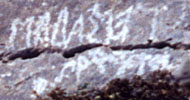 |
| Two samples of Ancient Theran script. A picture of the rock with these and others is on this page. (These two images do not expand when clicked). | |
Ancient Thera has very little interpretation. In effect there is only the map reproduced here. None of the site has been restored and the buildings are not labelled to help align the site with the map, so it is hard to make out what it might have been like, or even to understand which parts are Dorian, which Greek, and which Roman in many cases. Most of it seems to be Roman, but we couldn't tell for sure. Nevertheless, it is an impressive city, with many intersecting streets and enough standing walls and fallen columns to allow one some idea of what it might have been like. There is a massive stone wall going up the spine of the hill from the saddle where the parking lot is. There was one basement with its ceiling still supported by its columns, which was quite interesting to see.
What it might have been like to live in such a bleak, windswept place is another matter. For a place like that to be inhabited for a thousand years, people must have been very afraid of what might come over the sea to attack them--quite different from when that part of the Mediterranean was controlled by the Minoans!
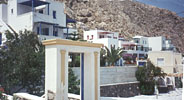 |
| Houses in Kamari at the base of the road to Ancient Thera |
After touring Ancient Thera, we walked back down the hairpin road to Kamari, keeping well out of the way of the cars and motorbikes driven by people braver than me. At the bottom of the road there was a street of houses with attractively coloured elements such as awnings. The square architecture is very typical of the region, from Knossos to contemporary. (The colours can be seen better in the bigger version of the picture.)
We picked up the car and drove to Fira for lunch once more at Naoussa, where we were recognized and welcomed. Then we drove to Oia. This is a fairly main road, but even so, in places it is a bit scary going round the side of steep hills with many sharp bends, cliffs on one side, and an unguarded drop on the other.
Oia is a very pretty place at the opposite end of the island from Akrotiri. In general appearance it is much like Fira, flowing over the cliff edge, though that edge seems less of an actual cliff than at Fira. There are lower segments of town, and a Venetian (?Roman) castle on a lower headland. There are lots of tourists, even as early in the season as the end of April. The view of the Caldera is quite different, because the strata are different. Presumably in the different explosive eruptions of the last million years, the winds blew sometimes in one direction, sometimes in another. The white ash from the most recent explosion, for example, mostly went south and east, so there isn't much of it in Oia, on the north side of the caldera.
 |
 |
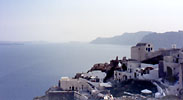 |
 |
Oia. (Left) A stair/street is a good place for young people to congregate. Nea Kameni in the background. (Above) The slope down to the caldera. In the background, Therassia. | |
| (Top) Church in Oia. (Bottom) I don't know what the scarecrow is for. Fira in the background. | You can see the ruins of a Venetian(?) castle in both of these pictures. | |
We wandered around Oia for a while, bought ice-cream, looked at souvenirs, and so on. The we drove back to the Volcano View Villas, where they were kind enough to allow us the use of a room to freshen up before catching the plane to Athens (we had officially checked out in the morning, but left our bags with the Reception). We left the car keys with the Reception, since we had booked it through the hotel.
If you would like to see lots more pictures of Santorini, and learn more about it, here is a delightful site devoted to the island .
Right on time, we were picked up by the Meridian minibus and taken to the airport. Check-in was normal, as in most airports, but things were a bit haphazard after that. There was no opportunity to get a bite to eat, which we had banked on, the plane was late, and when we got to Athens we went to the normal taxi rank, but there were almost no taxis and quite a few people waiting (this was the Olympic Airways terminal, after all, so one might have expected that, though it wasn't Olympic's fault). Eventually we got a taxi with an English couple going to the same hotel, near the airport rather than downtown. They were coming to Greece to make a boat shipshape that a consortium they belonged to had bought to use for time-sharing cruises. Sounded like a nice idea.
The taxi driver told us he thought he was the last taxi that would be at the airport until after midnight, because all the drivers were going to prepare for the midnight service (tomorrow being Easter Sunday). So was he, after dropping us off. At the hotel, the check-in clerk told us that most things would be closed the next day, so we would not be able to see the museums we had been interested in. The only tourist-friendly thing happening would be the Aegina-Epidauros-Hydra boat trip, so we booked that, which meant getting a wake-up call at 6:00 am (worse than on the bus tour!).
We walked around for a while to look for a place for dinner, but they were all closed, and in the end we managed to get a mini-pizza and a beer at the hotel bar.